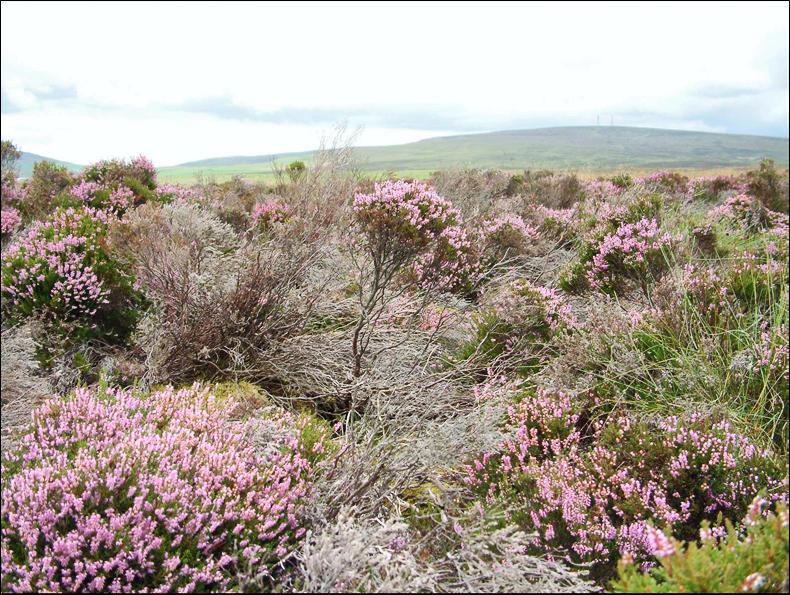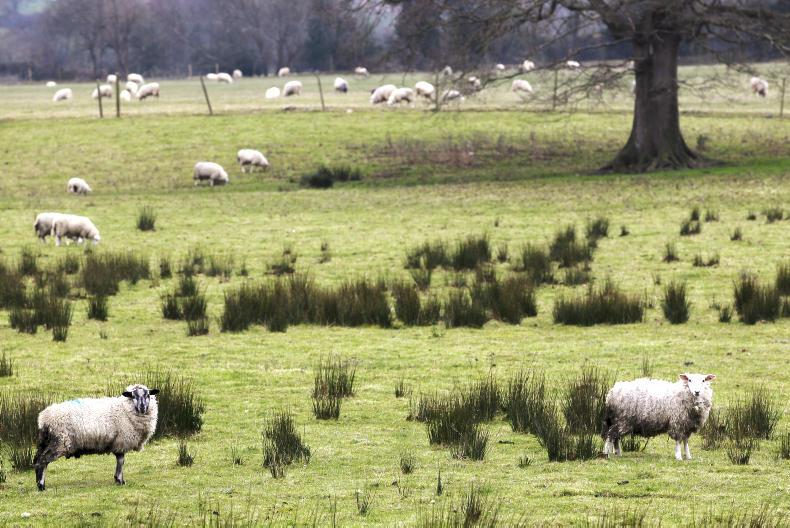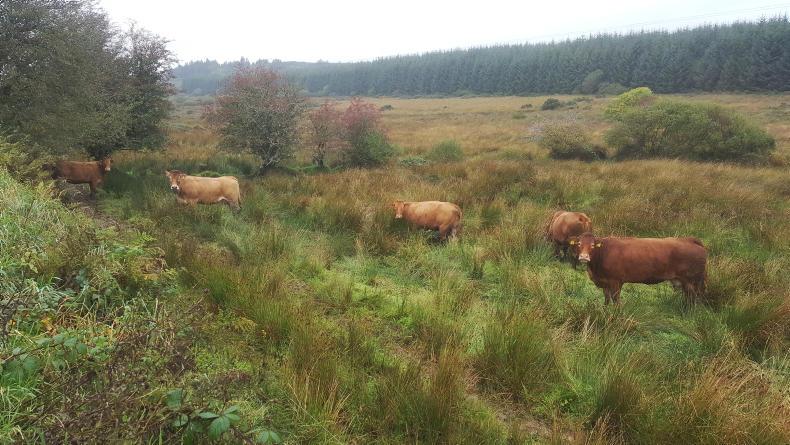With over 1,000 farmers fined a total of €220,000 as a result of land eligibility checks in 2016, farmers must do their upmost to ensure they do not get a penalty for declaring land that, after inspection, is ineligible. With all farmers due to complete the Basic Payment Scheme (BPS) form online this year, it is an area farmers need to take care of.
A total of 771 farmers had a reduction in eligible area imposed of less than 3% or less than 2ha after an inspection in 2016. This could be for a number of reasons such as scrub encroachment, rushes taking over in grazing ground or areas of hill land and commonages.
Ensure payment
To claim payment under the 2018 BPS, all land must be declared by the farmer, either owned, rented or leased. The land must be used for an agricultural activity for a period from the beginning of the year until after 31 May 2018 or for a period before 31 May 2018 to 31 December 2018. This rule is slightly different when it comes to Area of Natural Constraint (ANC), AEOS and GLAS, where farmers must have control of the land for the entire year. An 11-month conacre agreement is also eligible for ANC payments.
In order to draw down payment through the BPS, the land must be used for agricultural activity and maintained in a state suitable for grazing or cultivation without preparatory actions going beyond usual agricultural methods and machineries.
If a farmer is aware that a land parcel, or part of a parcel is going to be used for non-agricultural purposes during 2018, this must be excluded from the BPS application. Where a farmyard is being extended or a farm roadway is being installed or a site taken out for a house, for example, these areas must be removed. Farmers are permitted to make amendments to their BPS application up until 31 May 2018 without receiving a penalty. After this date, amendments will be accepted up to and including 9 June. However, a penalty of 1% will be applied to the parcel(s) concerned for each working day after 31 May.
Requirements
For land to be eligible for BPS, there must be independent and suitable access to all parcels for livestock and/or machinery. Independent access means access by public or private roadway or by a defined right of way. Access through adjoining landowners’ property is not acceptable. There must also be clearly defined external boundaries, except in the case of commonages. This allows the area to be measured.
Appropriate fencing must also be in place to ensure that the farmer is in control of the parcel. This fence must be stock-proof, which will not only control animals belonging to the applicant but also the neighbouring farmer’s animals and prevent them from encroaching.

Heather that develops into tall woody heather and can no longer being accessed by animals is ineligible.Heather that develops into tall woody heather and can no longer being accessed by animals is ineligible.
Issues to beware of
The main issues why land was ineligible in 2017 were:
Failure to exclude ineligible parcels.Failure to exclude ineligible features or areas from the declared area of a land parcel.Failure to apply the appropriate percentage reduction to the declared area of a land parcel where areas of scrub, rock, etc, exist.Failure to exclude whole or partial areas of parcels which are not subject to an agricultural activity or maintained in a state suitable for grazing or cultivation.Failure to exclude lands which are no longer owned or rented by the applicant.Ineligible land
Land that is used predominantly for non-agricultural purposes is not eligible for either BPS or ANC payments. Other parcels that are ineligible include where they are not under control of the farmer or no agricultural activity is being carried out by the farmer.
Land under permanent crops that are non-rotational crops, other than permanent pasture, that occupy the land for five years or longer and yield repeated harvests. Any land where an agricultural activity cannot be carried out because of pre-existing restriction such as a NPWS commonage framework plan prohibiting grazing. Bogland, whether used for turf production or not, is ineligible. However, blanket bog used for agricultural purposes is eligible. Farmyards, roadways and concreted or gravelled areas are not eligible, neither are ponds, rivers, streams, outcropping rocks, scrub, quarries, sand and gravel pits or areas fenced off to exclude livestock. Areas of land that are ungrazed due to low stocking rates are also ineligible. Marshy or wet areas that are permanently too wet for animals or machinery to enter are not eligible and must be deducted in full from the parcel area. Where farm roadways are fenced off from the adjoining fields then the area between the fence lines is ineligible. This is important to note for farmers who recently installed new farm roadways. Areas under dense scrub with no interspersed grazing must be deducted as 100% ineligible. Where widely scattered scrub or rock exists within a parcel, it is acceptable to apply a percentage reduction to the whole area of the parcel, eg a 5% reduction applied to the whole parcel. One aspect that effected a lot of farmers last year was in relation to burned land. Where land has been burned, it is not in a state suitable for grazing or cultivation and therefore is not eligible. The exception to this is where controlled burning is carried out in full compliance with all relevant environmental legislative requirements.
Digitising of parcels
Digitising of land parcels is required to ensure that ineligible features/areas are excluded from the eligible area to be used for payment purposes. The need for digitising can arise in the following circumstances:
An applicant has submitted a request to amend the eligible area of a land parcel at time of application;.An applicant is selected for a land eligibility inspection and during the inspection process ineligible parcels or features/areas within parcels are identified. Administrative checks on applications and new imagery acquired for the LPIS identify ineligible features/areas.The EU regulations governing the Basic Payment Scheme, and other area-based schemes, require that a minimum of 5 % of beneficiaries are inspected to ensure compliance with land eligibility requirements. Delays in payment may not be directly attributed to the fact that an application requires digitising or an inspection to be completed, other issues such as changes in ownership, transfer of entitlements or other scheme eligibility criteria may need to be resolved before the payment due can be finalised and issued.

Parcels that contain young rushes such as these, that have been controlled through grazing or mowing/topping, are deemed eligible.Parcels that contain young rushes such as these, that have been controlled through grazing or mowing/topping, are deemed eligible.
Three big issues when it comes to eligibility are rushes, heather and ferns. We will look in more detail at what is allowed and what is not. Just because land has been eligible in previous years does not mean that this is still the case.
Land with heather which is not grazed and has become mature and woody is not eligible, for example.
This may apply to a whole parcel or part of a parcel but either way appropriate deductions must be made.
Rushes: when it comes to rushes, parcels will be ineligible where they are not being accessed by grazing animals which has led to them growing tall. Where rushes have got very dense and are not being accessed by animals, they will also be ineligible. Again, in the case of rushes where they have developed and become dominant in a parcel, a percentage reduction can be applied to that area. Parcels that contain young rushes that have been controlled through grazing or mowing/topping are deemed eligible. Where rushes are increasing in density but there is still evidence of grazing by animals, the parcel will be eligible. However, ongoing management is required to avoid the land becoming ineligible.
Heather: similar to rushes, for heather to be eligible, it must be low, immature heather that is edible for sheep, in particular, and some cattle. Where appropriate grazing is not taking place, the chances are that the heather has developed into tall, woody heather, which is no longer being accessed by animals and is therefore ineligible. Again, where ineligible heather is present, either the whole parcel or a percentage of it must be deducted. Ferns: ferns or bracken are inedible to farm livestock. For land with ferns to be eligible for BPS payments, it must have grass present underneath that can result in it being grazed. Where there is no grass underneath then it is not eligible and must be deducted accordingly. Read more
Commonage farmers to be paid €14.50 per hour
2018 key year for commonage stocking levels
Satellite inspection 'difficulties and delays' to be resolved for 2018
With over 1,000 farmers fined a total of €220,000 as a result of land eligibility checks in 2016, farmers must do their upmost to ensure they do not get a penalty for declaring land that, after inspection, is ineligible. With all farmers due to complete the Basic Payment Scheme (BPS) form online this year, it is an area farmers need to take care of.
A total of 771 farmers had a reduction in eligible area imposed of less than 3% or less than 2ha after an inspection in 2016. This could be for a number of reasons such as scrub encroachment, rushes taking over in grazing ground or areas of hill land and commonages.
Ensure payment
To claim payment under the 2018 BPS, all land must be declared by the farmer, either owned, rented or leased. The land must be used for an agricultural activity for a period from the beginning of the year until after 31 May 2018 or for a period before 31 May 2018 to 31 December 2018. This rule is slightly different when it comes to Area of Natural Constraint (ANC), AEOS and GLAS, where farmers must have control of the land for the entire year. An 11-month conacre agreement is also eligible for ANC payments.
In order to draw down payment through the BPS, the land must be used for agricultural activity and maintained in a state suitable for grazing or cultivation without preparatory actions going beyond usual agricultural methods and machineries.
If a farmer is aware that a land parcel, or part of a parcel is going to be used for non-agricultural purposes during 2018, this must be excluded from the BPS application. Where a farmyard is being extended or a farm roadway is being installed or a site taken out for a house, for example, these areas must be removed. Farmers are permitted to make amendments to their BPS application up until 31 May 2018 without receiving a penalty. After this date, amendments will be accepted up to and including 9 June. However, a penalty of 1% will be applied to the parcel(s) concerned for each working day after 31 May.
Requirements
For land to be eligible for BPS, there must be independent and suitable access to all parcels for livestock and/or machinery. Independent access means access by public or private roadway or by a defined right of way. Access through adjoining landowners’ property is not acceptable. There must also be clearly defined external boundaries, except in the case of commonages. This allows the area to be measured.
Appropriate fencing must also be in place to ensure that the farmer is in control of the parcel. This fence must be stock-proof, which will not only control animals belonging to the applicant but also the neighbouring farmer’s animals and prevent them from encroaching.

Heather that develops into tall woody heather and can no longer being accessed by animals is ineligible.Heather that develops into tall woody heather and can no longer being accessed by animals is ineligible.
Issues to beware of
The main issues why land was ineligible in 2017 were:
Failure to exclude ineligible parcels.Failure to exclude ineligible features or areas from the declared area of a land parcel.Failure to apply the appropriate percentage reduction to the declared area of a land parcel where areas of scrub, rock, etc, exist.Failure to exclude whole or partial areas of parcels which are not subject to an agricultural activity or maintained in a state suitable for grazing or cultivation.Failure to exclude lands which are no longer owned or rented by the applicant.Ineligible land
Land that is used predominantly for non-agricultural purposes is not eligible for either BPS or ANC payments. Other parcels that are ineligible include where they are not under control of the farmer or no agricultural activity is being carried out by the farmer.
Land under permanent crops that are non-rotational crops, other than permanent pasture, that occupy the land for five years or longer and yield repeated harvests. Any land where an agricultural activity cannot be carried out because of pre-existing restriction such as a NPWS commonage framework plan prohibiting grazing. Bogland, whether used for turf production or not, is ineligible. However, blanket bog used for agricultural purposes is eligible. Farmyards, roadways and concreted or gravelled areas are not eligible, neither are ponds, rivers, streams, outcropping rocks, scrub, quarries, sand and gravel pits or areas fenced off to exclude livestock. Areas of land that are ungrazed due to low stocking rates are also ineligible. Marshy or wet areas that are permanently too wet for animals or machinery to enter are not eligible and must be deducted in full from the parcel area. Where farm roadways are fenced off from the adjoining fields then the area between the fence lines is ineligible. This is important to note for farmers who recently installed new farm roadways. Areas under dense scrub with no interspersed grazing must be deducted as 100% ineligible. Where widely scattered scrub or rock exists within a parcel, it is acceptable to apply a percentage reduction to the whole area of the parcel, eg a 5% reduction applied to the whole parcel. One aspect that effected a lot of farmers last year was in relation to burned land. Where land has been burned, it is not in a state suitable for grazing or cultivation and therefore is not eligible. The exception to this is where controlled burning is carried out in full compliance with all relevant environmental legislative requirements.
Digitising of parcels
Digitising of land parcels is required to ensure that ineligible features/areas are excluded from the eligible area to be used for payment purposes. The need for digitising can arise in the following circumstances:
An applicant has submitted a request to amend the eligible area of a land parcel at time of application;.An applicant is selected for a land eligibility inspection and during the inspection process ineligible parcels or features/areas within parcels are identified. Administrative checks on applications and new imagery acquired for the LPIS identify ineligible features/areas.The EU regulations governing the Basic Payment Scheme, and other area-based schemes, require that a minimum of 5 % of beneficiaries are inspected to ensure compliance with land eligibility requirements. Delays in payment may not be directly attributed to the fact that an application requires digitising or an inspection to be completed, other issues such as changes in ownership, transfer of entitlements or other scheme eligibility criteria may need to be resolved before the payment due can be finalised and issued.

Parcels that contain young rushes such as these, that have been controlled through grazing or mowing/topping, are deemed eligible.Parcels that contain young rushes such as these, that have been controlled through grazing or mowing/topping, are deemed eligible.
Three big issues when it comes to eligibility are rushes, heather and ferns. We will look in more detail at what is allowed and what is not. Just because land has been eligible in previous years does not mean that this is still the case.
Land with heather which is not grazed and has become mature and woody is not eligible, for example.
This may apply to a whole parcel or part of a parcel but either way appropriate deductions must be made.
Rushes: when it comes to rushes, parcels will be ineligible where they are not being accessed by grazing animals which has led to them growing tall. Where rushes have got very dense and are not being accessed by animals, they will also be ineligible. Again, in the case of rushes where they have developed and become dominant in a parcel, a percentage reduction can be applied to that area. Parcels that contain young rushes that have been controlled through grazing or mowing/topping are deemed eligible. Where rushes are increasing in density but there is still evidence of grazing by animals, the parcel will be eligible. However, ongoing management is required to avoid the land becoming ineligible.
Heather: similar to rushes, for heather to be eligible, it must be low, immature heather that is edible for sheep, in particular, and some cattle. Where appropriate grazing is not taking place, the chances are that the heather has developed into tall, woody heather, which is no longer being accessed by animals and is therefore ineligible. Again, where ineligible heather is present, either the whole parcel or a percentage of it must be deducted. Ferns: ferns or bracken are inedible to farm livestock. For land with ferns to be eligible for BPS payments, it must have grass present underneath that can result in it being grazed. Where there is no grass underneath then it is not eligible and must be deducted accordingly. Read more
Commonage farmers to be paid €14.50 per hour
2018 key year for commonage stocking levels
Satellite inspection 'difficulties and delays' to be resolved for 2018








 This is a subscriber-only article
This is a subscriber-only article











SHARING OPTIONS: